Overview
This article highlights critical electrical grid fire safety measures that facilities must adopt to avert fire hazards and ensure safety. It underscores the necessity of:
- Regular maintenance checks
- The use of fire-resistant materials
- Comprehensive training programs
- The installation of smoke detectors
- Clear evacuation plans
- The accessibility of fire extinguishers
- Monitoring electrical loads
- Maintaining access to electrical panels
- Conducting regular fire drills
Each of these measures is backed by statistical evidence and case studies that demonstrate their effectiveness in mitigating fire risks.
Introduction
In an age where electrical fires pose a significant threat to safety and infrastructure, the importance of comprehensive fire safety measures cannot be overstated. With billions of dollars lost to fire incidents over the past decade, organizations are increasingly recognizing the need for proactive strategies to mitigate risks associated with electrical systems. This article delves into essential practices:
- Conducting regular maintenance checks
- Utilizing fire-resistant materials
- Implementing effective training programs
- Ensuring the accessibility of fire extinguishers
By exploring these strategies, organizations can not only comply with safety regulations but also foster a culture of safety that protects personnel and assets alike.
Harbinger Land | Comprehensive Solutions for Electrical Grid Fire Safety
Harbinger Land stands at the forefront of managing the complexities of land services for energy and infrastructure initiatives, particularly in implementing electrical grid fire safety measures. Utilizing cutting-edge technology and an experienced team, the company delivers comprehensive solutions that ensure compliance with regulations while enhancing operational efficiency. Their expertise in site acquisition and GIS mapping facilitates strategic planning that prioritizes risk management in electrical installations, emphasizing the necessity of electrical grid fire safety measures, especially in light of the staggering $23.2 billion in dollar losses from blazes reported between 2014 and 2023.
Furthermore, case studies reveal that many incidents, including those related to recreational vehicles, can be prevented through meticulous precautionary measures, particularly electrical grid fire safety measures. As a trusted partner, Harbinger Land is committed to helping organizations mitigate risks, ensuring that safety remains paramount in power grid management. By addressing the challenges faced by the industry, Harbinger Land not only safeguards investments but also fosters a culture of safety that benefits all stakeholders.
Conduct Regular Maintenance Checks on Electrical Systems
Conducting routine maintenance inspections on power systems is essential for identifying wear and tear, loose connections, and other potential safety hazards. Alarmingly, statistics reveal that approximately 50% of power-related incidents stem from maintenance oversights, underscoring the critical need for preventive measures.
Facilities must establish a comprehensive maintenance timetable that includes inspections of:
- Wiring
- Circuit breakers
- Other power components
By addressing issues promptly, organizations can significantly reduce the risk of electrical fires and ensure the safety of their premises by implementing electrical grid fire safety measures. It is vital to view maintenance not merely as a compliance requirement but as a strategic investment in security and operational efficiency.
For instance, the case study titled 'Proactive Electrical Maintenance' highlights the advancements of NFPA 70B and its positive impact on enhancing safety in technologically advanced settings. Developing a maintenance schedule entails regular assessments and timely interventions, which are crucial for maintaining both safety and operational efficiency in facilities.

Utilize Fire-Resistant Materials in Electrical Installations
Including heat-resistant substances in wiring setups is crucial for enhancing safety and mitigating ignition hazards. The use of temperature-resistant cables, conduits, and enclosures designed to withstand high heat significantly lowers the risk of incidents. For example, flame retardant cables are widely utilized in data centers, where they are essential in safeguarding server racks and power distribution units from potential dangers.
The U.S. Consumer Product Safety Commission (CPSC) reports that power outlets are linked to approximately 5,300 fires annually, resulting in 40 fatalities and over 100 injuries. This underscores the necessity of implementing robust protective measures, including electrical grid fire safety measures, such as:
- Using fire-rated materials
- Conducting thorough inspections of electrical systems
- Installing smoke detectors
Successful case studies reveal that facilities employing these materials have seen a marked decrease in fire-related incidents, further emphasizing the need for proactive electrical grid fire safety measures. Expert insights indicate that training staff on the importance of fire precautions and the proper use of fire-resistant materials can enhance security protocols.
As Robert Bouchard, a rack protection specialist, states, "Train your employees on rack security and they’ll identify and report the damage. Empower them to report damage and you’ll avoid accidents."
By prioritizing the selection of appropriate fire-rated materials and steering clear of overloaded outlets, organizations not only protect personnel and equipment but also foster a safer operational environment.
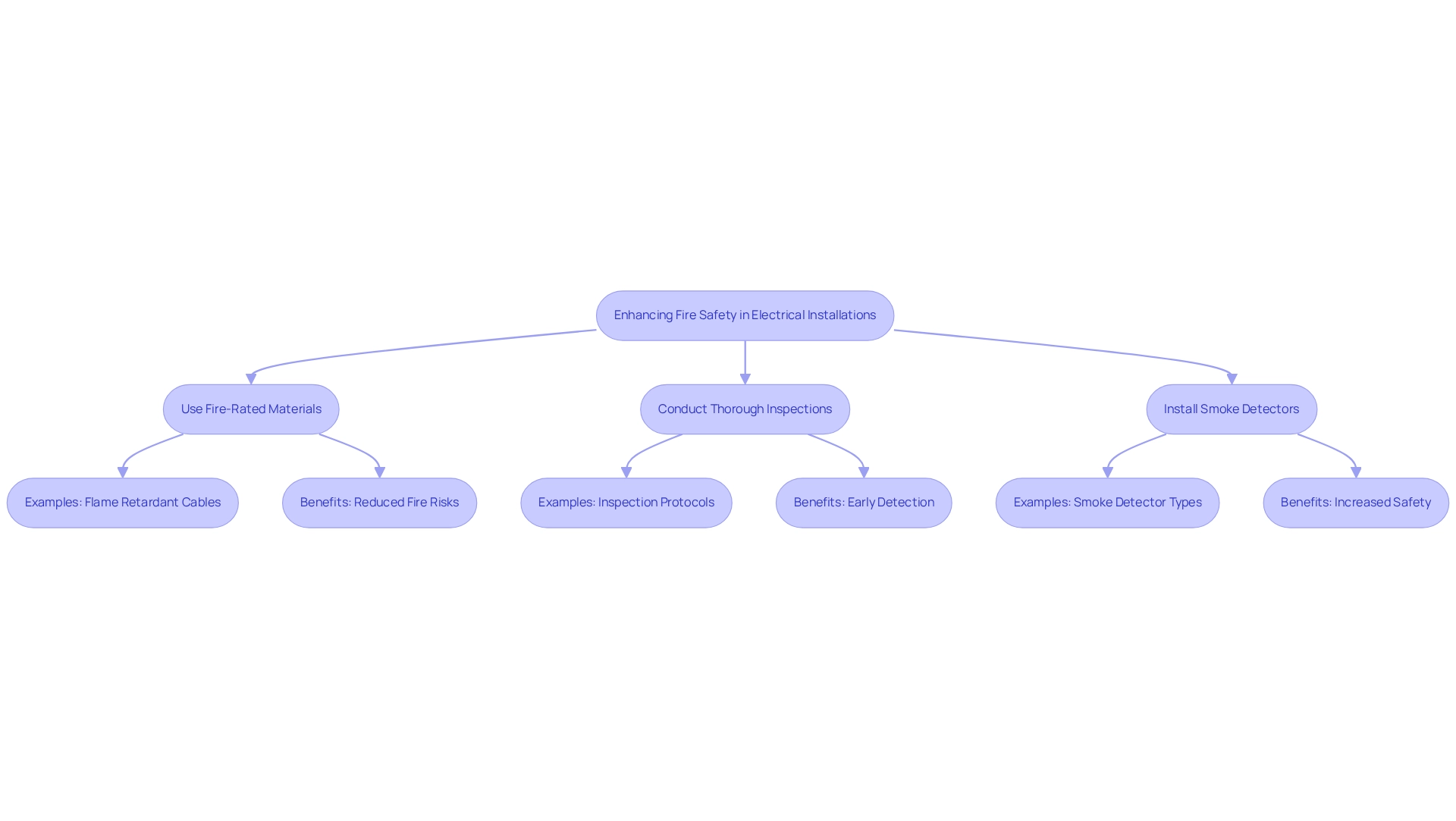
Implement Training Programs for Electrical Safety Awareness
Establishing training initiatives centered on power awareness is essential for all staff operating in power facilities. These programs must address critical topics such as:
- Identifying power hazards
- Proper equipment usage
- Emergency response procedures
Consistent training sessions ensure that employees remain alert and prepared to respond effectively in the event of a fire emergency, ultimately enhancing workplace security by incorporating electrical grid fire safety measures. Data from OSHA indicate that approximately 70% of workplace incidents stem from inadequate training in power protocols, underscoring the necessity of these programs.
Furthermore, the case study titled 'Enhancing Standards' highlights the importance of educating both certified and uncertified workers on safety protocols. As Scott Cam from The Block remarked, 'I’m pleased to observe how young individuals are taking initiative concerning security,' emphasizing the need to foster a culture of awareness.
Current trends in power training for establishments reveal an increasing focus on integrating technology and practical training techniques. To promote effective training programs, center directors should prioritize:
- Regular evaluations of training efficacy
- Actively seeking employee feedback to continually refine security protocols.

Install Smoke Detectors and Fire Alarms in Electrical Facilities
The installation of smoke detectors and alarm systems in electrical establishments is critical for adhering to electrical grid fire safety measures. These devices serve as the first line of defense, providing early warnings of smoke, which is vital for enabling swift evacuation and response. Regular testing and maintenance of these systems are imperative to verify their operational effectiveness. Compliance with local safety codes and regulations not only meets safety standards but also enhances the overall safety culture within the establishment.
Statistics reveal that a single wood-framed cabinet can generate a peak heat release rate nearly sufficient to cause flashover in a small room, underscoring the necessity of early detection systems in averting such perilous scenarios. This highlights the significance of smoke sensors and alarms in mitigating hazards associated with potential flashovers in power installations. Case studies on smoke detector technologies indicate that both ionization and photoelectric alarms effectively provide adequate escape time during home incidents, with each type demonstrating superior performance in different situations. It is essential to recognize that while these findings stem from residential contexts, they underscore the critical role of selecting appropriate alarm technology for specific environments, including electrical facilities.
Current adherence rates to alarm regulations in the U.S. are vital indicators for assessing preparedness. Specific data shows that compliance rates have been improving; however, gaps remain that necessitate attention to ensure comprehensive protection measures are in place. Optimal strategies for testing and maintaining alarm systems include:
- Conducting regular inspections
- Ensuring proper installation
- Staying updated with the latest regulations governing alarm systems in electrical installations
Experts consistently affirm that effective alarm systems are crucial for safeguarding energy infrastructure, making electrical grid fire safety measures not merely a regulatory requirement but a fundamental aspect of operational safety. As noted by Bukowski et al., "Consistent with prior findings, ionization type alarms provide somewhat better response to flaming fires than photoelectric alarms, and photoelectric alarms provide (often) considerably faster response to smoldering fires than ionization type alarms." This expert validation reinforces the necessity of installing appropriate alarm systems as essential electrical grid fire safety measures in power plants.
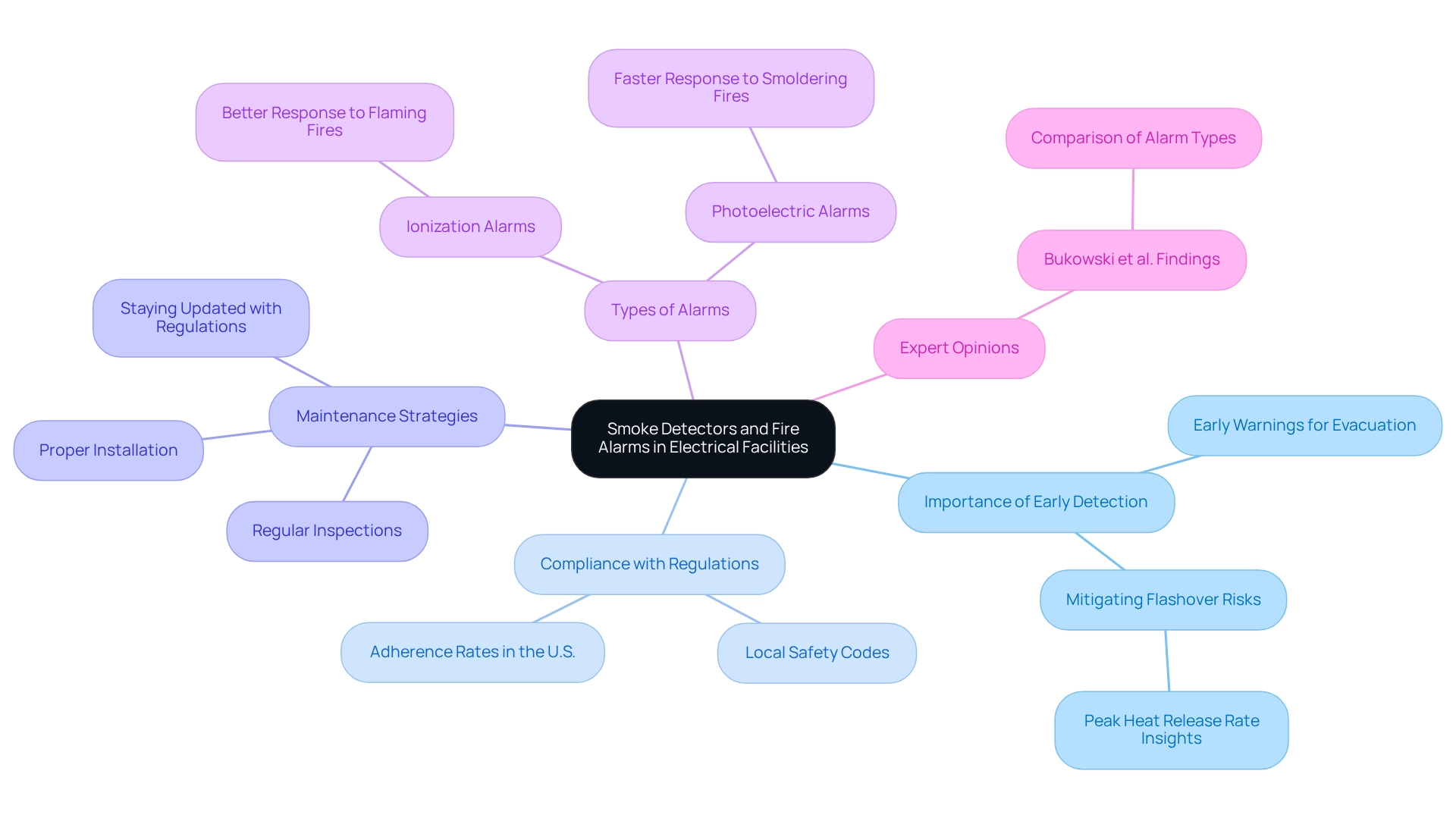
Establish Clear Evacuation Plans for Electrical Facilities
Establishing clear evacuation strategies for electrical installations is essential for safeguarding staff during emergencies. These plans must outline designated escape routes, assembly points, and procedures for accounting for all employees. Regular evacuation drills are vital; they not only familiarize staff with the process but also enhance their capacity to respond swiftly and effectively in the event of a fire.
Data indicate that organizations with well-developed evacuation strategies significantly reduce the risk of injury during emergencies, with over 70% of establishments reporting improved outcomes after implementing such measures. Expert advice emphasizes the necessity of involving all employees in the planning process to ensure a comprehensive understanding and adherence to protocols.
The effective execution of evacuation drills within energy initiatives demonstrates that proactive measures, such as regular evaluations and transparent communication of policies, foster a culture of security and readiness. Recent incidents have underscored the severe consequences of insufficient evacuation plans, reinforcing the imperative for organizations to prioritize these protocols.
Optimal procedures for evacuation strategies in power facilities involve:
- Frequent revisions of the plans
- Integrating feedback from drills
- Ensuring that all staff are trained and aware of their responsibilities during an emergency
As one risk expert aptly stated, 'Alert today – alive tomorrow,' underscoring the life-saving potential of well-executed evacuation strategies.
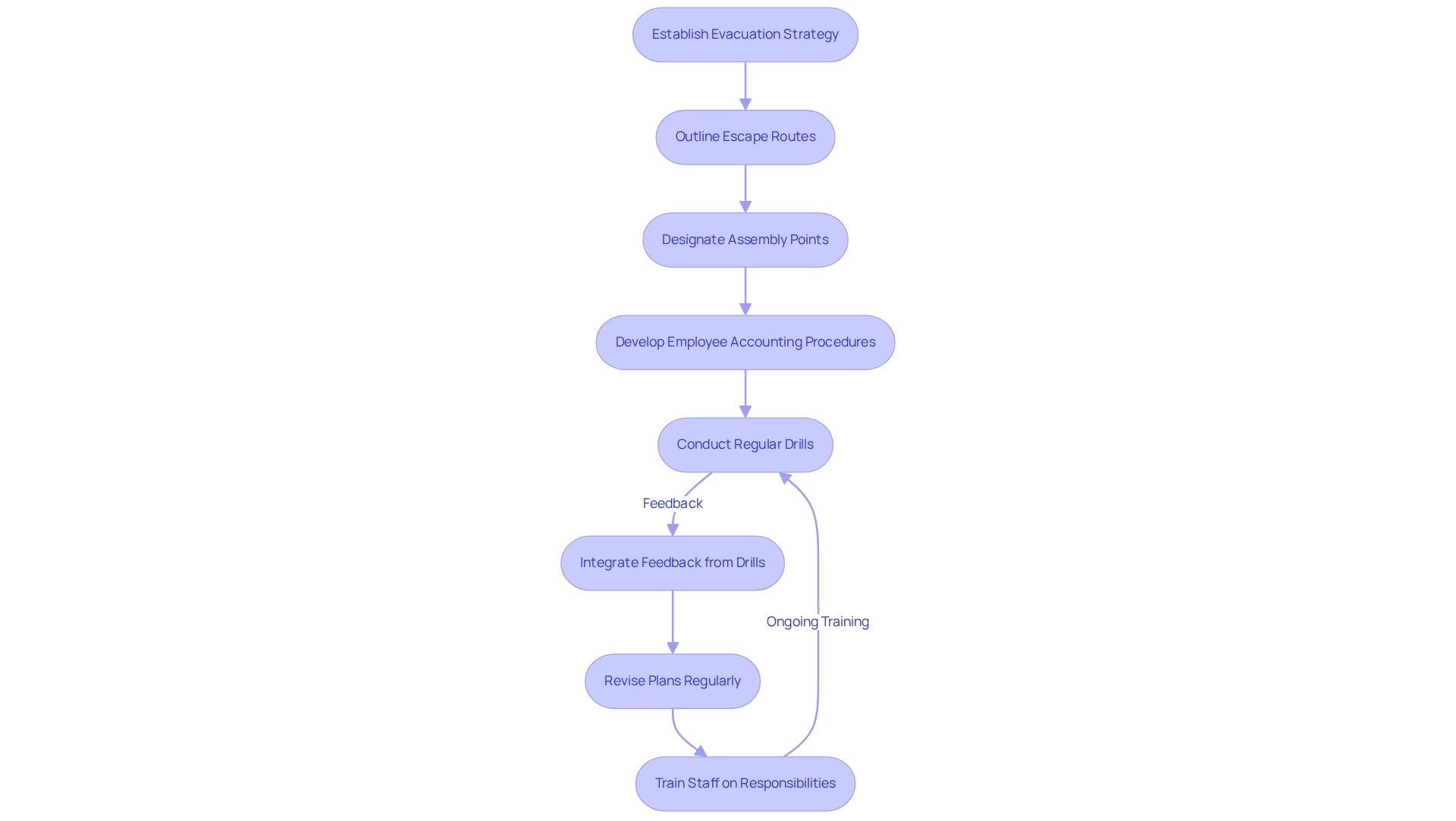
Ensure Accessibility of Fire Extinguishers in Electrical Areas
Ensuring the availability of extinguishers in electrical zones is one of the critical electrical grid fire safety measures. Flame suppressors must be strategically positioned near potential danger areas to comply with electrical grid fire safety measures and be readily accessible to all staff. Regular inspections and maintenance of these extinguishers are essential to confirm they are operational within the framework of electrical grid fire safety measures.
Training staff on the efficient use of extinguishers is essential for implementing electrical grid fire safety measures, empowering them to respond swiftly in emergencies. Leadership plays a crucial role in fostering a culture of safety, which is vital for the successful implementation of emergency prevention initiatives. Data indicates that comprehensive training can significantly reduce response times during emergencies, underscoring the need for ongoing education in emergency protocols.
As Walter Dill Scott noted, 'The future of the protection movement is not so much reliant on the creation of protective devices as on the enhancement of ways to educate individuals to the ideal of caution and security.'
Furthermore, adhering to the latest recommendations for extinguisher placement is crucial for the implementation of electrical grid fire safety measures, as this ensures compliance with existing regulations and enhances overall safety within facilities. Optimal practices suggest that extinguishers should be clearly labeled and easily accessible, and that regular drills reinforcing their importance are essential components of electrical grid fire safety measures in emergency preparedness.
The 2021 Limetree Bay Refinery shutdown serves as a stark reminder of the repercussions of neglecting safety protocols, highlighting the significance of regulatory compliance in upholding safety standards.
Monitor Electrical Loads to Prevent Overloads
Monitoring power loads is essential for ensuring electrical grid fire safety measures are in place to prevent overloads that can lead to overheating and fires. Facilities must implement advanced systems to track power usage, facilitating the detection of anomalies that may indicate potential overloads. For instance, deploying wired sensor solutions, such as the Vertiv™ Geist™ Watchdog, can significantly reduce installation time from days to mere hours, enabling quicker responses to power issues.
Proactive load management strategies have proven effective across various environments. A compelling case study on commercial building load management revealed that these strategies not only enhanced energy efficiency but also lowered operational costs. This highlights the dual benefits of efficient load monitoring: improved security and substantial cost savings, both critical to implementing electrical grid fire safety measures. Data indicates that power overload incidents account for approximately 30% of facility fires, underscoring the importance of monitoring energy consumption. Consistent oversight can help organizations mitigate these risks, ensuring the secure operation of their power systems through the implementation of electrical grid fire safety measures. Experts emphasize the necessity of fostering a culture of security through ongoing training and open discussions regarding power practices. As Robert Bouchard, a rack protection specialist, notes, empowering employees to report damage can prevent accidents and bolster overall security.
Current trends in power load monitoring involve the integration of AI and IoT technologies, which provide real-time data and analytics for enhanced decision-making. By prioritizing load management, organizations not only protect their resources but also enhance their reputation and operational success, as a commitment to well-being significantly contributes to a company's overall achievement.
Maintain Clear Access to Electrical Panels and Equipment
Ensuring unobstructed access to electrical panels and equipment is crucial for security and operational efficiency. Facilities must guarantee that pathways to these areas are clear and well-marked. According to the National Electrical Code (NEC), specific clearance standards are crucial electrical grid fire safety measures that enhance protection and mitigate liability risks for property owners. These owners may face compensation claims if injuries occur due to inadequate access.
Case studies, such as 'Best Practices for Electrical Panel Clearance,' provide valuable insights for maintaining proper clearance and underscore the importance of electrical grid fire safety measures, emphasizing that exceeding minimum standards can significantly bolster security and efficiency for all individuals accessing these panels.
Best practices include:
- Avoiding storage in clearance zones
- Clearly marking pathways to electrical equipment
- Conducting regular inspections to prevent obstructions
Additionally, the Occupational Safety and Health Administration (OSHA) imposes fines for violations, highlighting the importance of compliance. By prioritizing clear access, facilities can ensure adherence to regulations and foster a safer working environment by implementing electrical grid fire safety measures. This approach ultimately facilitates swift responses during emergencies and routine maintenance checks.
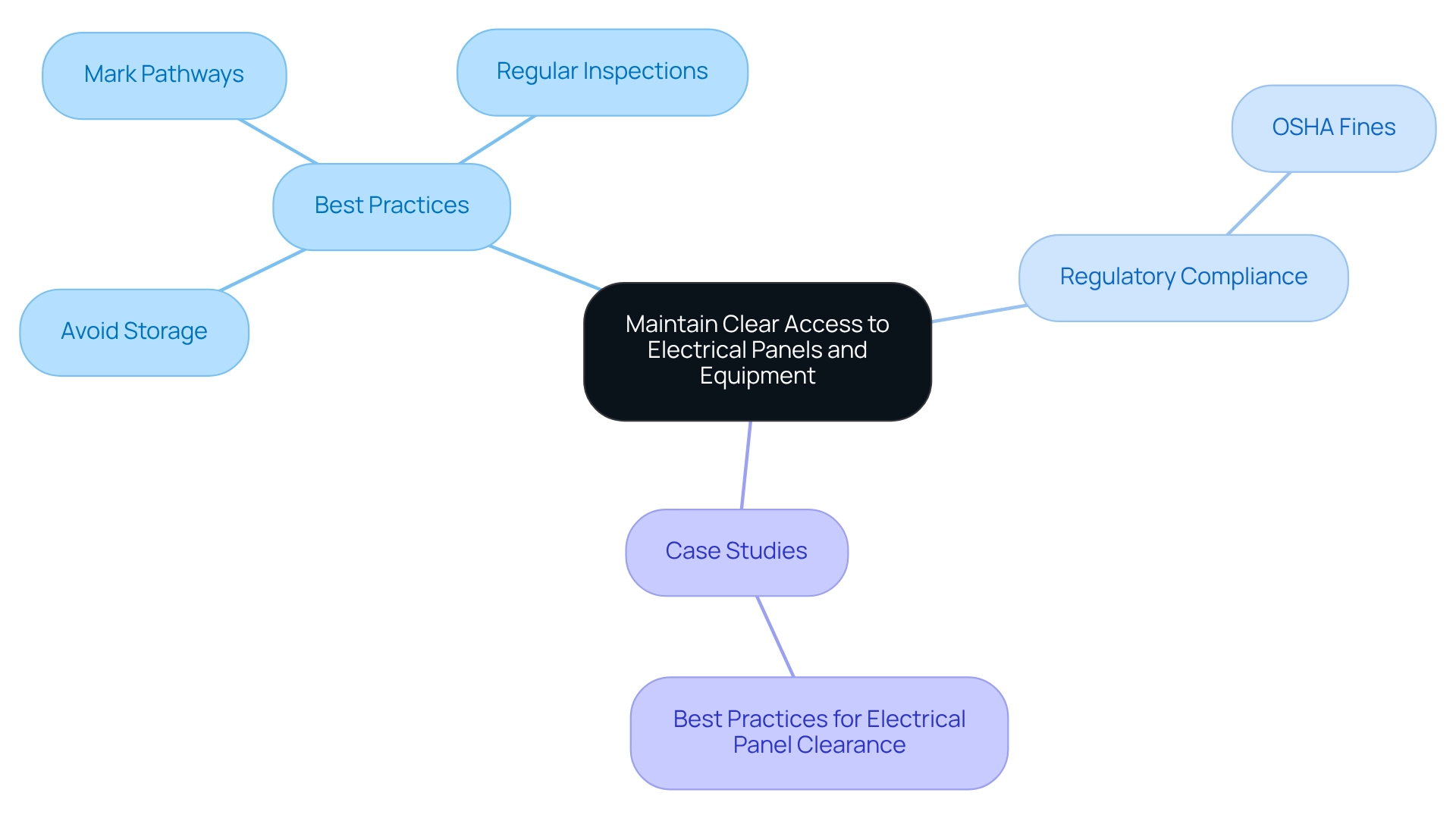
Conduct Regular Fire Drills and Safety Audits
Carrying out regular emergency drills and inspections is essential for guaranteeing readiness and adherence to regulations. Fire drills educate employees about evacuation procedures, while inspections assist in recognizing possible risks and areas for enhancement. By consistently assessing and revising protection protocols, organizations can improve their emergency response measures and guarantee a secure working environment.
Efficient drills must be practical, encompassing situations that staff may face. Effective fire drill initiatives in energy facilities demonstrate that involving employees in these practices fosters a culture of security, empowering individuals to respond effectively in emergencies. As Sean Lucas aptly stated, 'Any worker should be able to stop work if they feel there is a danger to continuing operations,' highlighting the significance of a proactive protection culture.
Furthermore, acknowledging and rewarding secure behavior can enhance this culture, ensuring employees are prepared and motivated to maintain safety standards in their daily operations. For additional guidance, organizations can refer to the 12 workplace safety tips for 2025, which provide valuable insights into enhancing safety practices.
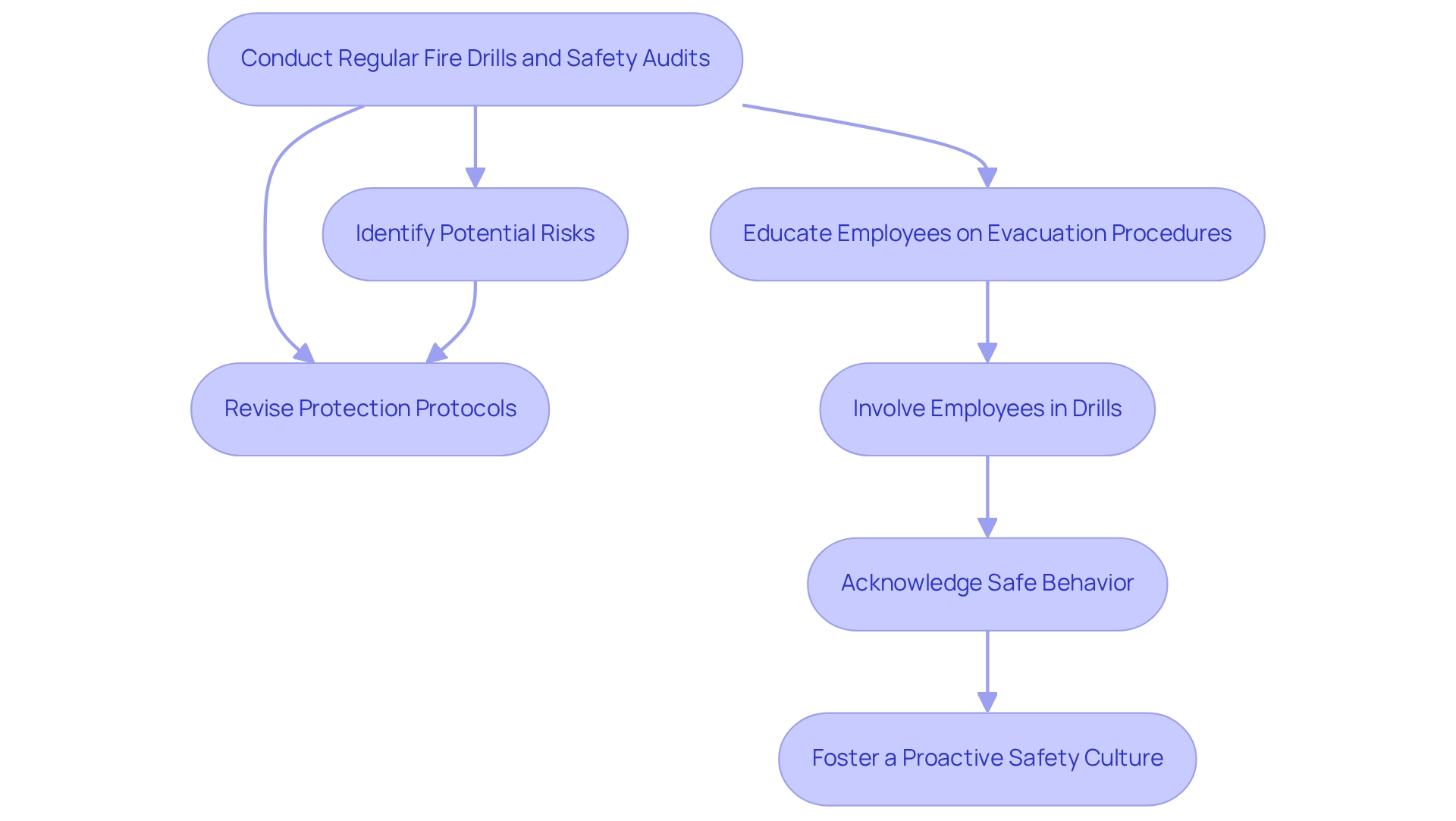
Conclusion
The implementation of comprehensive fire safety measures in electrical facilities transcends mere regulatory compliance; it stands as a cornerstone of safeguarding personnel and infrastructure. Regular maintenance checks empower organizations to identify potential fire hazards proactively, thereby significantly diminishing the risk of electrical fires, which represent a considerable percentage of incidents. The use of fire-resistant materials not only enhances safety but also mitigates risks associated with electrical installations. Furthermore, effective training programs foster a culture of safety awareness among employees.
Additionally, the installation of smoke detectors and fire alarms is vital for early detection, facilitating prompt action during emergencies. Clear evacuation plans and accessible fire extinguishers further bolster safety protocols, enabling organizations to respond adeptly to fire incidents. Continuous monitoring of electrical loads is essential to prevent overloads that could precipitate fires, while maintaining clear access to electrical panels ensures operational efficiency and readiness in emergencies.
Ultimately, integrating these practices not only aligns with safety regulations but also cultivates a proactive safety culture that prioritizes the well-being of all personnel. Organizations dedicated to fire safety not only protect their assets but also enhance their reputation and operational success, illustrating that safety is an investment in the future. The collective responsibility of implementing these measures is crucial for safeguarding lives and ensuring the resilience of electrical infrastructure against potential fire hazards.
Frequently Asked Questions
What services does Harbinger Land provide for energy and infrastructure initiatives?
Harbinger Land specializes in managing land services, particularly focusing on implementing electrical grid fire safety measures. They utilize advanced technology and an experienced team to deliver comprehensive solutions that ensure regulatory compliance and enhance operational efficiency.
Why are electrical grid fire safety measures important?
Electrical grid fire safety measures are crucial due to the significant financial losses associated with fires, totaling approximately $23.2 billion from 2014 to 2023. These measures help mitigate risks and prevent incidents, ensuring safety in power grid management.
What role does maintenance play in electrical safety?
Routine maintenance inspections are essential for identifying potential safety hazards in power systems. About 50% of power-related incidents are attributed to maintenance oversights, highlighting the need for a comprehensive maintenance schedule that includes inspections of wiring, circuit breakers, and other power components.
What should a maintenance timetable include?
A comprehensive maintenance timetable should include regular inspections of wiring, circuit breakers, and other power components to promptly address issues and reduce the risk of electrical fires.
How can heat-resistant materials enhance electrical safety?
Including heat-resistant substances in wiring setups, such as flame retardant cables, significantly lowers the risk of ignition hazards. These materials are essential in environments like data centers to protect equipment from potential dangers.
What protective measures should be implemented for electrical systems?
Protective measures include using fire-rated materials, conducting thorough inspections of electrical systems, and installing smoke detectors to enhance safety and prevent fire-related incidents.
How can employee training contribute to electrical safety?
Training staff on fire precautions and the proper use of fire-resistant materials can improve security protocols. Empowering employees to identify and report damage helps prevent accidents and enhances overall safety.
What is the significance of proactive electrical grid fire safety measures?
Proactive measures, such as using appropriate fire-rated materials and avoiding overloaded outlets, not only protect personnel and equipment but also foster a safer operational environment. Successful case studies indicate that these measures lead to a marked decrease in fire-related incidents.
List of Sources
- Harbinger Land | Comprehensive Solutions for Electrical Grid Fire Safety
- Statistics (https://usfa.fema.gov/statistics)
- 12 unforgettable quotes from NRG Energy CEO David Crane (https://utilitydive.com/news/12-unforgettable-quotes-from-nrg-energy-ceo-david-crane/227117)
- Top 100 Warehouse Safety Quotes for Toolbox Talks, Posters & Meetings (https://damotech.com/blog/inspirational-quotes-warehouse-safety)
- Conduct Regular Maintenance Checks on Electrical Systems
- NFPA 70B: What the Change Means for Maintenance, Operations and Safety - Electrical Safety Foundation International (https://esfi.org/nfpa-70b-what-the-change-means)
- The Hidden Costs of Neglecting Electrical Maintenance: A Facilities Manager's Wake-Up Call - Facilities Management Advisor (https://facilitiesmanagementadvisor.com/maintenance-and-operations/the-hidden-costs-of-neglecting-electrical-maintenance-a-facilities-managers-wake-up-call)
- Electrical Fires: Causes and Safety Tips | SafetyCulture (https://safetyculture.com/topics/electrical-hazards/electrical-fire)
- Utilize Fire-Resistant Materials in Electrical Installations
- Top 100 Warehouse Safety Quotes for Toolbox Talks, Posters & Meetings (https://damotech.com/blog/inspirational-quotes-warehouse-safety)
- esfi.org (https://esfi.org/home-electrical-fires)
- Flame Retardant Cables: Enhancing Safety in Electrical Installations - cable news - ZMS Cable (https://m.zmscable.com/new/Flame-Retardant-Cables-Enhancing-Safety-in-Electrical-Installations)
- Implement Training Programs for Electrical Safety Awareness
- Electrical Safety Statistics: Why Are Workers Still Dying on the Job - Electrical Safety in the Workplace (https://electricalsafetypub.com/features/electrical-safety-statistics-why-are-workers-still-dying-on-the-job)
- 190+ Quotes to Motivate Your Co-Workers About Safety Training (https://onlinesafetytrainer.com/190-quotes-to-motivate-your-co-workers-about-safety-training)
- Install Smoke Detectors and Fire Alarms in Electrical Facilities
- Smoke Alarm Research (https://nist.gov/el/smoke-alarm-research)
- Basics of Fire Detection and Alarm System (https://torrencesound.com/industry-news-blog/basics-fire-detection-alarm-system)
- Establish Clear Evacuation Plans for Electrical Facilities
- Kashiwa-no-ha Smart City: Making smart use of local energy sources to build the communities of the future : Social Innovation : Hitachi (https://social-innovation.hitachi/en-us/case_studies/smartcity_kashiwanoha)
- Top 40+ Workplace Safety Quotes To Improve Your Safety Culture (https://flowdit.com/workplace-safety-quotes)
- Top 100 Warehouse Safety Quotes for Toolbox Talks, Posters & Meetings (https://damotech.com/blog/inspirational-quotes-warehouse-safety)
- Ensure Accessibility of Fire Extinguishers in Electrical Areas
- 22 Workplace Safety Quotes From Leaders and Experts - AlertMedia (https://alertmedia.com/blog/workplace-safety-quotes)
- Top 100 Warehouse Safety Quotes for Toolbox Talks, Posters & Meetings (https://damotech.com/blog/inspirational-quotes-warehouse-safety)
- 190+ Quotes to Motivate Your Co-Workers About Safety Training (https://onlinesafetytrainer.com/190-quotes-to-motivate-your-co-workers-about-safety-training)
- Monitor Electrical Loads to Prevent Overloads
- Electrical Overloads - FasterCapital (https://fastercapital.com/term/electrical-overloads.html)
- What Is Power Monitoring and Why Does It Matter? (https://vertiv.com/en-asia/about/news-and-insights/articles/educational-articles/what-is-power-monitoring-and-why-does-it-matter)
- Top 100 Warehouse Safety Quotes for Toolbox Talks, Posters & Meetings (https://damotech.com/blog/inspirational-quotes-warehouse-safety)
- Maintain Clear Access to Electrical Panels and Equipment
- What are the Minimum Clearance Requirements for Electrical Panels? (https://creativesafetysupply.com/qa/electrical-safety/what-are-the-minimum-clearance-requirements-for-electrical-panels?srsltid=AfmBOoqzEFJQp_Dz5gbXwM5r5CG2BA-IFmfBGBdjaqFK4S7wqO38apJ8)
- Electrical Panel Clearance Requirements & Safety |TRADESAFE (https://trdsf.com/blogs/news/electrical-panel-clearance-requirements-and-safety?srsltid=AfmBOoqKsEK9bbyXpTYlDCn8hTACGcvn255JSvgOTt8QpsIQpPI--rFP)
- Conduct Regular Fire Drills and Safety Audits
- Top 100 Warehouse Safety Quotes for Toolbox Talks, Posters & Meetings (https://damotech.com/blog/inspirational-quotes-warehouse-safety)
- 22 Workplace Safety Quotes From Leaders and Experts - AlertMedia (https://alertmedia.com/blog/workplace-safety-quotes)
- Famous Safety Quotes - HSE STUDY GUIDE (https://hsestudyguide.com/famous-safety-quotes)




